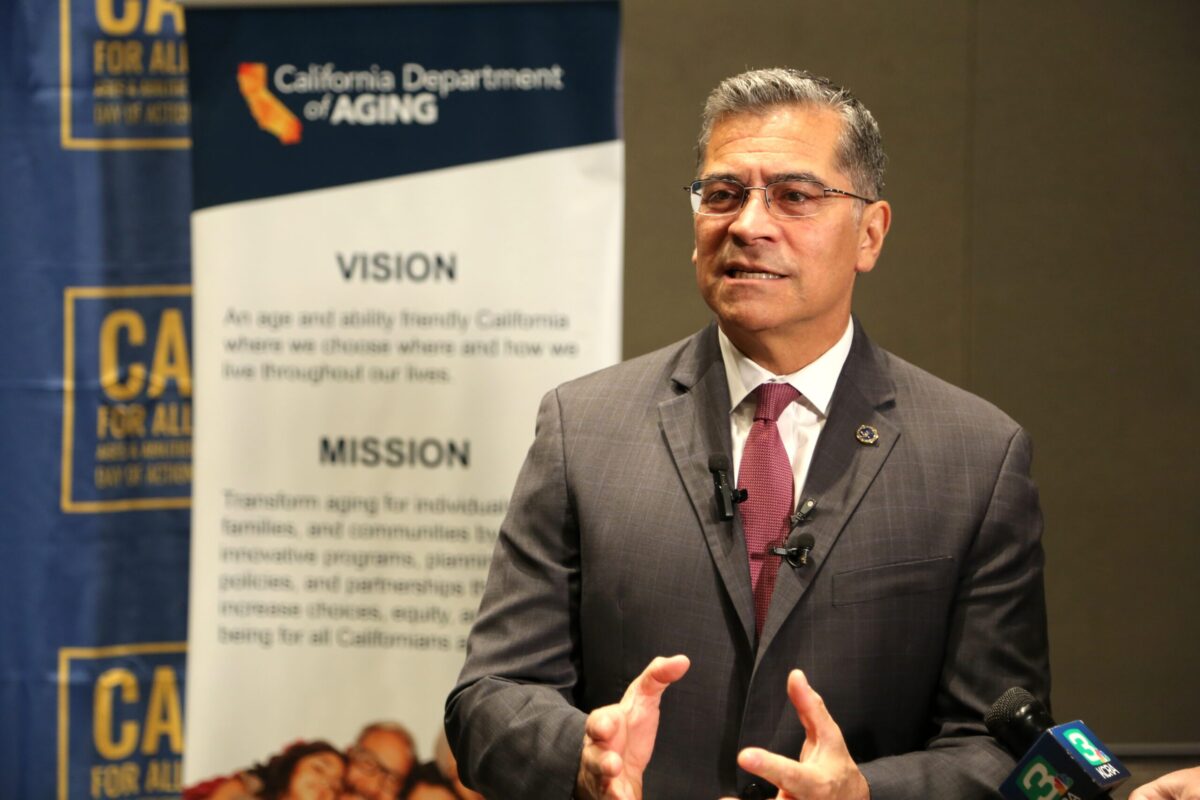SACRAMENTO, California — California punches at a very high weight when it comes to novel initiatives to help its residents age comfortably in their homes, said Health and Human Services Secretary Xavier Becerra here Oct. 8, during the California Department of Aging’s Day of Action.
The event brought together leaders from several state agencies and disability and aging advocates who discussed advances in California’s 10-year Master Plan on Aging.
The MPA is a 10-year blueprint addressing inequities for older adults and disabled people. California Department of Aging Director Susan DeMarois kicked off the event, stating: “We are seeing the real impacts of our work, every day.” In the third round, the most pressing needs of older adults will be addressed, including housing, health, transportation, and support for caregivers, she said.
By 2030, the state’s population of older adults will have grown to 8.6 million; 1 out of 4 residents in California will be over the age of 65.
Using Medicaid to Fund Housing and Transportation
“So much of the policy that you see starting to surface at the federal level really comes from places like California that have pushed the envelope. The state has tried some things, sometimes failed, but learned from it, and then pushed further. So California helps move the nation in the right direction,” said Becerra in his keynote remarks.
One novel innovation is the expansion of Medicaid dollars to meet critical services such as housing, food, and transportation, he said. In 2022, Governor Gavin Newsom unveiled a new plan for MediCal (California’s version of Medicaid) that allowed recipients to use funds for housing deposits, transportation to medical services, and medically-tailored meals. Several states have adopted similar plans for Medicaid dollars.
“Promoting wellness is making sure people can get to their doctor’s appointments, have safe housing with clean water, and healthy food,” said Becerra.
Housing and Homelessness
Remaining housed is a critical issue for older adults. In California, 171,000 people are experiencing homelessness; 46% are over the age of 50, according to data from the Benioff Housing and Homeless Initiative. That number is expected to triple over the next decade. In 2023, 3,200 older adults who were homeless died on the streets in Los Angeles County. Senate President Pro Tempore Mike McGuire, who also spoke at the CDA’s Day of Action, said California must be “laser focused” on older adults facing homelessness. He advocated for building more affordable senior housing.
Funding from federal sources can be used to solve California’s crisis of older adult homelessness, said Becerra. Funds from Medicaid could be combined with monies from Housing and Urban Development, the Substance Abuse and Mental Health Services Administration, the Department of Veterans Affairs, and Housing and Human Services, he said, noting that local jurisdictions should not have to worry about siloed funds.
“We’re trying to give the local jurisdictions flexibility with those different federal dollars,” said Becerra.
In an interview with Ethnic Media Services on the sidelines of the Day of Action, Tomiquia Moss, Secretary of the California Business, Consumer Services and Housing Agency, noted there was a lot of “not in my backyard” response to building affordable housing in certain neighborhoods. “We have to get our own voices in the room,” she stated.
Her goal is to build 2.5 million homes by 2030, including 1 million units of affordable housing. Moss wants to increase the number of Accessory Dwelling Unit — ADUs — tiny, affordable homes on the lots of larger homes which allow seniors to live independently. 90% of people who are moved from homelessness into housing stay housed, said Moss.
In one of the most-moving panels of the day, three community members spoke about their challenges in accessing support for their own disabilities or that of a family member. Priscilla Yeung dreamed of being a concert pianist but lost her sight at the age of 13. She fell into a deep depression as she struggled to manage the basic tasks of daily living. A blind friend told her about the Society for the Blind, where she learned how to navigate the world with a white cane.
Older Asians who lose their sight say they will not walk on the streets for fear of being attacked, said Yeung. “They fear not being safe in their communities and getting hurt because they are Asian and vulnerable,” she said.
Choking up many times as he spoke, Alli Kato spoke about the challenges of finding culturally-appropriate nursing home care for his godmother Kyoko, who had helped to raise him. San Francisco resident Elaine Samuels spoke about the intense bureaucracy she faced while trying to apply for Social Security benefits and MediCal, after she lost her job for medical reasons during the Covid-19 pandemic.
One of the biggest challenges for older adults is transportation. Paratransit is an awkward service: users must switch vans and wait for another — sometimes two hours outdoors — if they are traveling from one county to another. Riders must schedule their needs 24 hours in advance, and face a two-hour window to wait for their rides, which makes scheduling medical appointments difficult.
Michelle Dusey, who uses a wheelchair, told EMS of the challenges of going from home to work every day. “We just want to get around like everyone else,” she stated.
Mark Tollefson, undersecretary at the California State Transportation Agency, told EMS that upgrading Paratransit and van pools was “not an easy task,” as much of the policy is determined at the federal level. Asked if there was an opportunity to create a public/private partnership using existing rideshare services like Lyft and Uber, Tollefson said similar ideas were under consideration, but unlikely to be implemented due to cost.
Sheri Burns, of the Disability & Aging Community Living Advisory Committee — DACLAC — noted that SB 1121 and SB 125 seek to improve the state’s public transportation systems, including services for older adults and disabled people.
Several advocacy groups offered their recommendations for the third round of the MPA. Among the suggestions were:
- More resources for unpaid family caregivers
- Raising wages for caregivers, many of whom now work at minimum wage or less, if paid under the table
- Increasing the number of paid caregivers from 600,000 to 3 million by 2030
- Support for AB846, which caps rent increases
- Aggregating data from various state agencies to get a more complete picture of what residents are facing
- Addressing ageism and disability discrimination at workplaces and increasing the population of older and disabled adults working in the public sector
- Expanding adult day care so that family caregivers can get a meaningful respite
- Expanding the pool of community health workers
Nicole Vasquez, deputy chief consultant for the California state Assembly Budget Committee, advised advocacy organizations to merge their needs and come up with smaller budgetary asks, amid the state’s $40 billion budget deficit.
Jawan Trotter, fiscal and policy analyst for the Legislative Analyst’s Office, told EMS: “We still have a large budget. Services are being funded, and can be expanded. But there has to be the will to do so.”




